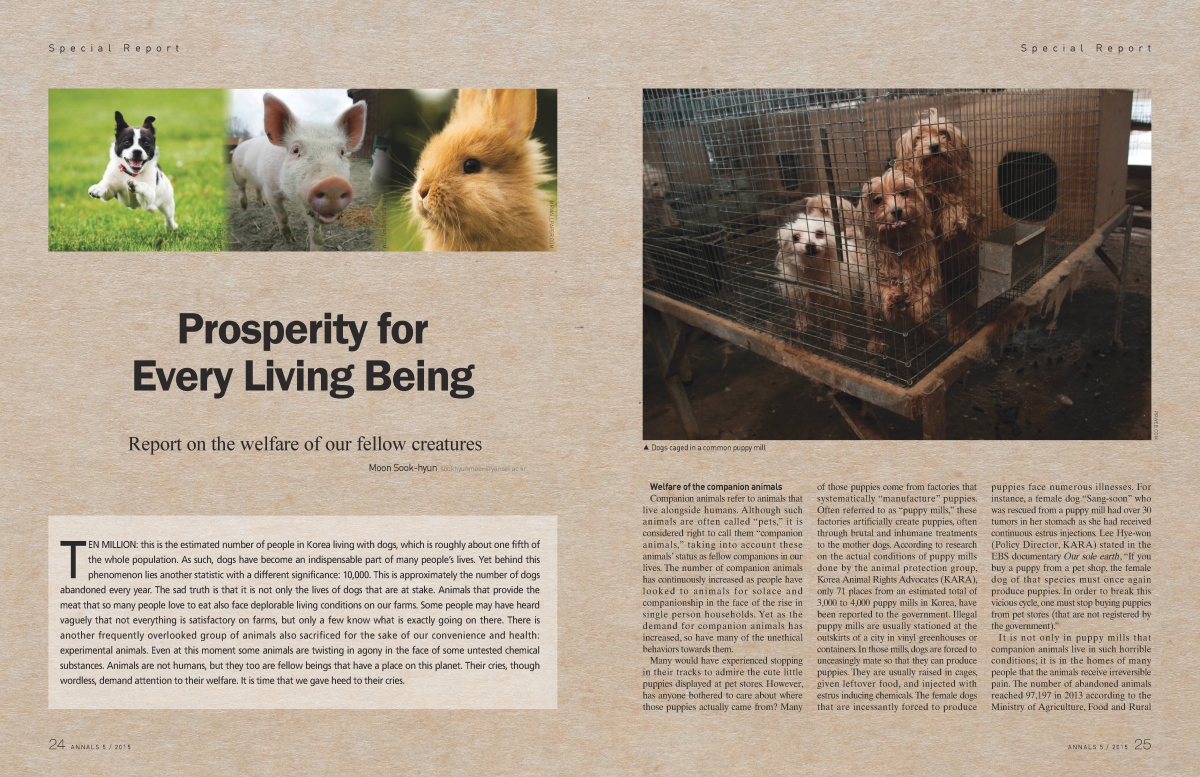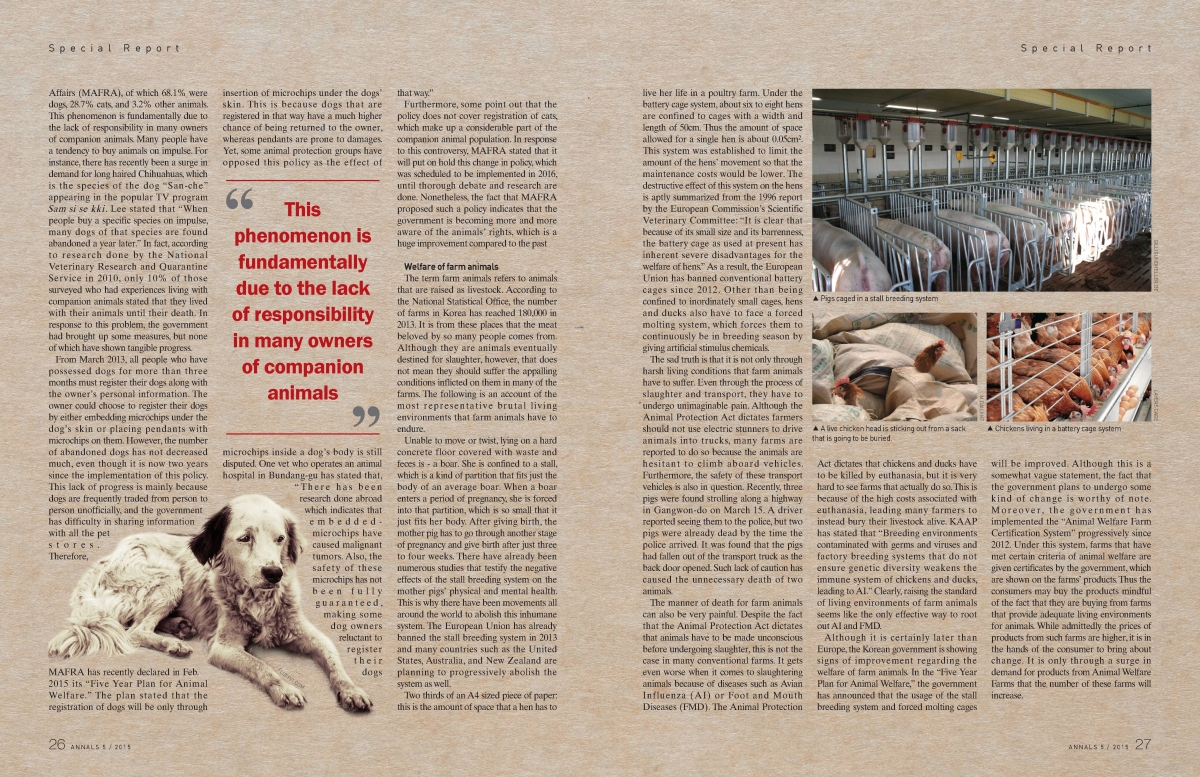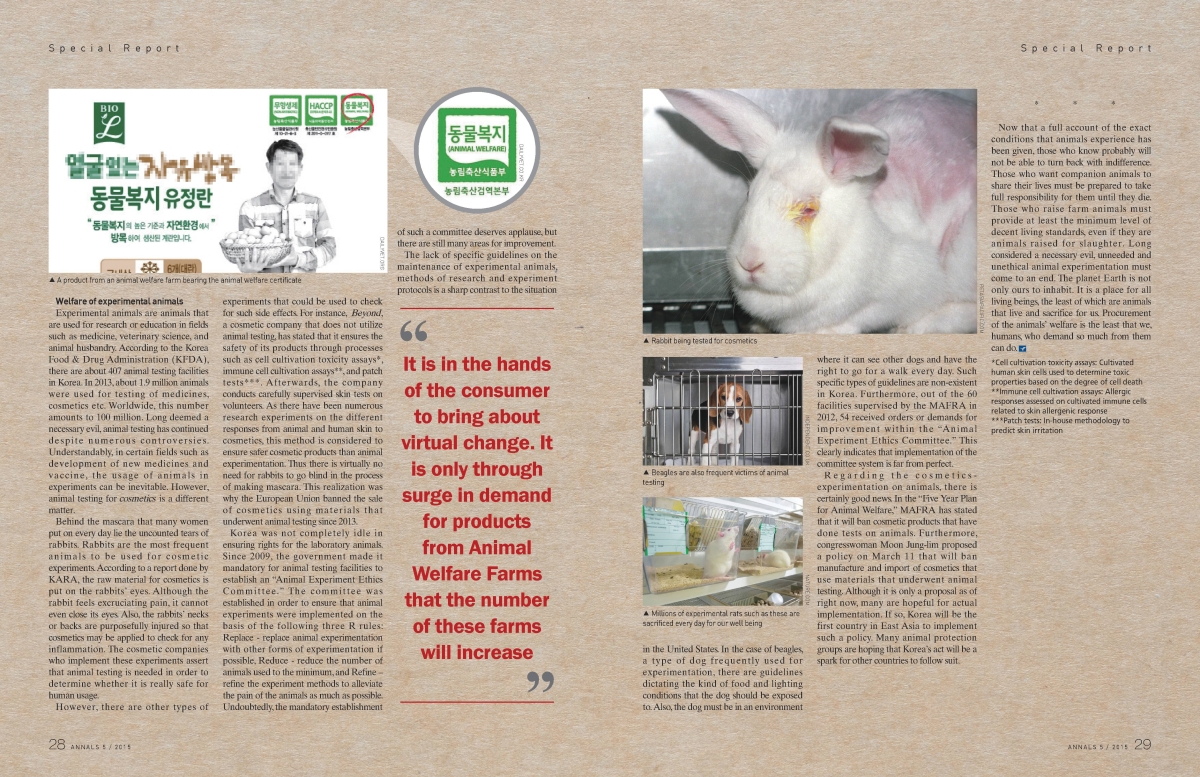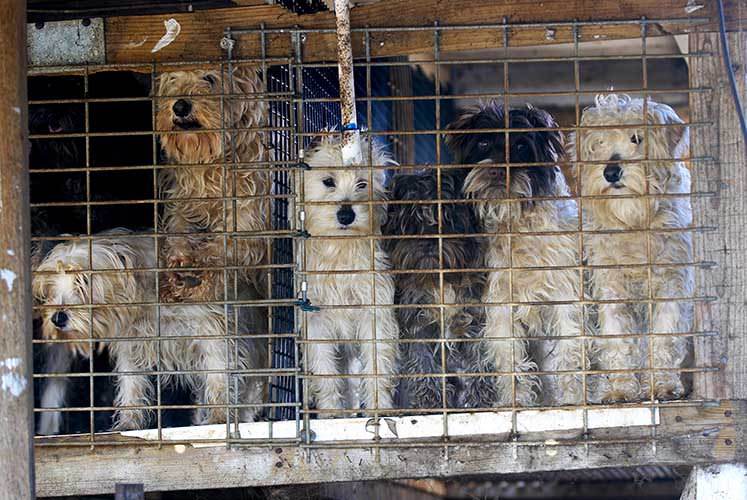Report on the welfare of our fellow earthlings




TEN MILLION: this is the estimated number of people in Korea living with dogs, which is roughly about one fifth of the whole population. As such, dogs have become an indispensable part of people’s lives. Yet, behind this phenomenon lies another number of a different significance: 10,000. This is approximately the number of dogs abandoned every year. The sad truth is that it is not only the lives of dogs that are at stake. Animals that provide the meat that so many people love also face deplorable conditions of life in the farms. Some people may have heard vaguely that not everything is aright in farms, but only a few know what is exactly going on in there. There is another frequently overlooked group of animals also sacrificed for the sake of our convenience and health: experimental animals. Even at this moment some animals are twisting in agony in the face of some untested chemical substances. Animals are not humans, but they too are fellow beings that have a place in this planet. Their cries, though wordless, demand attention to their welfare. It is time that we gave heed to their cries.
Welfare of the companion animals
Companion animals refer to animals that live alongside humans. Although such animals are often called as “pets,” it is considered right to call them as “companion animals,” taking into account the animals’ status as fellow companions in our lives. The number of companion animals continuously increased as people looked to animals for solace and companionship in the face of increasing single households. Yet as the demand for companion animals increased, so did many of the unethical behaviors towards them.
Many would have experienced stopping in their tracks to admire the cute little puppies displayed at pet stores. However, has anyone bothered to care about where those puppies actually came from? Many of those puppies come from factories that systematically “manufacture” puppies. Often referred to as “puppy mills,” these virtual factories artificially create puppies, often through brutal inhumane treatments to the mother dogs. According to a research on the actual conditions of puppy mills done by the animal protection group, Korea Animal Rights Advocates (KARA), only 71 places from an estimated total of 3,000 to 4,000 puppy mills in Korea, have been reported to the government. Illegal puppy mills are usually stationed at the outskirts of a city in vinyl greenhouses or containers. In those mills, dogs are forced to unceasingly mate so that they can produce puppies. They are usually raised in cages, given leftover food, and injected with estrus inducing chemicals. The female dogs that are incessantly forced produce puppies face numerous illnesses. For instance, a female dog “Sang-soon” who was rescued from a puppy mill had over 30 tumors in her stomach as she had received continuous estrus injections. Lee Hye-won (Policy Director, KARA) stated in the EBS documentary *Our sole earth*, “If you buy a puppy from a pet shop, the female dog of that species must once again produce puppies. In order to break this vicious cycle, one must stop buying puppies from pet stores (that are not registered by the government).”
It is not only in puppy mills that companion animals live in such horrible conditions; it is in the homes of many people that the animals receive irreversible pain. The number of abandoned animals has reached 97,197 in 2013 according to Ministry of Agriculture, Food and Rural Affairs (MAFRA), of which 68.1% were dogs, 28.7% cats, and 3.2% other animals. This phenomenon is fundamentally due to the lack of responsibility in many owners of companion animals. Many people have a tendency to buy animals on impulse. For instance, there had recently been a surge in demand for long haired Chihuahua, which is the species of the dog “San-che” appearing in the popular TV program *Sam si se kki*. Lee stated that “When people buy a specific species on impulse, many dogs of that species are found abandoned a year later.” In fact, according to a research done by National Veterinary Research and Quarantine Service in 2010, only 10% of those surveyed who had experiences living with companion animals stated that they lived with their animals until their death. In response to this problem, the government had brought up some measures, but none of which have shown tangible progress.
From March 2013, all people who have possessed dogs for more than three months must register their dogs along with the owner’s personal information. The owner could choose to register their dogs by either embedding microchips under the dog’s skin or placing pendants with microchips. However, the number of abandoned dogs has not decreased much even though it is now two years since the implementation of this policy. This lack of progress is mainly because dogs are frequently traded from person to person unofficially, and the government has difficulty in sharing information with all the pet stores. Therefore, MAFRA has recently declared in Feb. 2015 its “Five Year Plan for Animal Welfare.” The plan stated that the registration of dogs will be only through insertion of microchips under the dogs’ skin. This is because dogs that are registered in that way have a much higher chance of being returned to the owner, whereas pendants are prone to damages. Yet, some animal protection groups have opposed to this policy as the effect of microchips inside the dogs’ body is still disputed. One vet who operates an animal hospital in Bundang-gu has stated that, “There has been research done abroad which indicates that embedded microchips have caused malignant tumors. Also, the safety of these microchips has not been fully guaranteed, making some dog owners reluctant to register their dogs that way.”
Furthermore, some point out that the policy does not cover registration of cats, which take up a considerable part of the companion animal population. In response to this controversy, MAFRA stated that it will put on hold this change in policy, which was scheduled to be implemented in 2016, until thorough debate and research are done. Nonetheless, the fact that MAFRA proposed such a policy indicates that the government is becoming more and more aware of the animals’ rights, which is a huge improvement compared to the past.
Welfare of the farm animals
Farm animals refer to animals that are raised as livestock. According to the National Statistical Office, the number of farms in Korea has reached 180,000 in 2013. It is from these places that the beloved meat of so many people comes from. However, although they are animals eventually destined for slaughter, that does not mean they should suffer the insufferable conditions of life provided to them in many of the farms. The following is an account of the most representative brutal living environments that farm animals have to endure.
Unable to move or twist, lying on a hard concrete floor covered with waste and feces is - a boar. She is confined to a stall, which is a kind of partition that fits just the body of an average boar. When a boar enters a period of pregnancy, she is forced into that partition, which is so small that it just fits her body. After giving birth, the mother pig has to go through another stage of pregnancy and give birth after just three to four weeks. There have already been numerous studies that testify the negative effects of the stall breeding system on the mother pigs’ physical and mental health. This is why there have been movements all around the world to abolish this inhumane system. The European Union has already banned the stall breeding system in 2013 and many countries such as the United States, Australia, and New Zealand are planning to progressively abolish the system as well.
Two thirds of an A4 sized paper: this is the amount of space that a hen has to live her life in a poultry farm. Under the battery cage system, about six to eight hens are confined to cages with a width and length of 50cm. Thus the amount of space allowed for a single hen is about 0.05cm2. This system was established to limit the amount of the hens’ movement so that the maintenance costs would be lower. The destructive effect of this system on the hens is aptly summarized from the 1996 report by the European Commission’s Scientific Veterinary Committee: “It is clear that because of its small size and its barrenness, the battery cage as used at present has inherent severe disadvantages for the welfare of hens.” As a result, the European Union has banned conventional battery cages since 2012. Other than being confined to inordinately small cages, hens and ducks also have to face forced molting system, which forces them to continuously be in breeding season by giving artificial stimulus chemicals.
The sad truth is that it is not only through harsh living conditions that farm animals have to suffer. Even through process of slaughter and transport, they have to undergo unimaginable pain. Although the Animal Protection Act dictates farmers not to use electric stunners to drive animals into trucks, many farms are reported of doing so because the animals are hesitant to climb aboard vehicles. Furthermore, the safety of these transport vehicles is also in question. Recently, three pigs were found strolling along a highway in Gangwon-do on March 15. A driver reported seeing them to the police, but two pigs were already dead by the time the police arrived. It was found that the pigs had fallen out of the transport truck as the back door opened. Such lack of caution has caused an unnecessary death of two animals.
The way of death for farm animals can also be very much painful. Despite the fact that the Animal Protection Act dictates that animals have to be made unconscious before undergoing slaughter, it is not the case in many conventional farms. It gets even worse when it comes to slaughtering animals because of diseases such as Avian Influenza (AI) or Foot and Mouth Diseases (FMD). The Animal Protection Act dictates that chickens and ducks have to be killed by euthanasia, but it is very hard to see farms that actually do so. This is because of the high costs associated with euthanasia, leading many farmers to instead bury their livestock alive. KAAP has stated that “Breeding environments contaminated with germs and viruses and factory breeding systems that do not ensure genetic diversity weakens the immune system of chickens and ducks, leading to AI.” Clearly, raising the standard of living environments of farm animals seems like the only effective way to root out AI and FMD.
Although it is certainly later than Europe, the Korean government is showing signs of improvement regarding the welfare of farm animals. In the “Five Year Plan for Animal Welfare,” the government has announced that the usage of stall breeding system and forced molting cages will improve. Although this is a somewhat vague statement, the fact that the government plans to undergo some kind of change is worthy of noting. Moreover, the government has implemented the “Animal Welfare Farm Certification System” progressively since 2012. Under this system, farms that have met certain criteria of animal welfare are given certificates by the government, that are shown on the farms’ products. Thus the consumers may buy the products mindful of the fact that they are buying from farms that provide adequate living environments for animals. While admittedly the prices of products from such farms are higher, it is in the hands of the consumer to bring about virtual change. It is only through surge in demand for products from Animal Welfare Farms that the number of these farms will increase.
Welfare of experimental animals
Experimental animals are animals that are used for research or education on fields such as medicine, veterinary science, and animal husbandry. According to Korea Food & Drug Administration (KFDA), there are about 407 animal testing facilities in Korea. In 2013, about 1.9 million animals were used for testing on medicine, cosmetics etc. Worldwide, this number amounts to 100 million. Long deemed a necessary evil, animal testing has continued despite numerous controversies. Understandably, in certain fields such as development of new medicine and vaccine, usage of animals in experiments can be inevitable. However, animal testing on *cosmetics* is a different matter.
Behind the mascara that many women put on every day lie uncounted tears of rabbits. Rabbits are the most frequent animals to be used for cosmetic experiments. According to a report done by KARA, raw material for cosmetics is put on the rabbits’ eyes. Although the rabbit feels excruciating pain, it cannot even close its eyes. Also, the rabbits’ necks or backs are purposefully injured so that cosmetics may be applied to check for any inflammation. The cosmetic companies who implement these experiments assert that animal testing is needed in order to determine whether it is really safe for human usage.
However, there are other types of experiments that could be used to check for such side effects. For instance, *Beyond*, a cosmetic company that does not utilize animal testing, has stated that it ensures the safety of its products through processes such as cell cultivation toxicity assays*, immune cell cultivation assays**, and patch tests***. Afterwards, the company conducts carefully supervised skin tests on volunteers. As there have been numerous researches on the different responses from animal and human skin to cosmetics, this method is considered to ensure safer cosmetic products than animal experimentation. Thus there is virtually no need for rabbits to go blind in the process of making mascara. This realization was why the European Union banned the sale of cosmetics using materials that underwent animal testing since 2013.
Korea was not completely idle in ensuring rights for the laboratory animals. Since 2009, the government made it mandatory for animal testing facilities to establish an “Animal Experiment Ethics Committee.” The committee was established in order to ensure that animal experiments were implemented on the basis of the following the three R rules: Replace - replace animal experimentation with other forms of experimentation if possible, Reduce - reduce the number of animals used to the minimum, and Refine – refine the experiment methods to alleviate the pain of the animals as much as possible. Undoubtedly mandatory establishment of such a committee deserves applause, but there are still many areas for improvement.
Lack of specific guidelines on the maintenance of experimental animals, method of research and experiment is a sharp contrast to the situation in the United States. In the case of beagles, a type of dog frequently used for experimentation, there are guidelines dictating the kind of food and lighting conditions that the dog should be exposed to. Also, the dog must be in an environment where it can see other dogs and have the right to go for a walk every day. Such specific types of guidelines are non-existent in Korea. Furthermore, out of the 60 facilities supervised by the MAFRA in 2012, 54 received orders or demands for improvement within the “Animal Experiment Ethics Committee.” It clearly indicates that implementation of the committee is far from the perfect.
Regarding the cosmetics experimentation on animals, there is certainly good news. In the “Five Year Plan for Animal Welfare,” MAFRA has stated that it will ban cosmetic products that have done tests on animals. Furthermore, congresswoman Moon Jung-lim proposed a policy on March 11 that will ban manufacture and import of cosmetics that used materials that underwent animal testing. Although it is only a proposal as of right now, many are hopeful for actual implementation. If so, Korea will be the first country in East Asia to implement such a policy. Many animal protection groups are hoping that Korea’s act will be a spark for other countries to follow suit.
* * *
Now that a full account of the exact conditions of lives that animals lead has been given, those who know probably will not be able to turn back in indifference. Those who want companion animals to share their lives with must be prepared to take full responsibility of them until they die. Those who raise farm animals must provide at least the minimum level of decent living standards even if they are animals raised for slaughter. Long considered a necessary evil, unneeded and unethical animal experimentation must come to an end. The planet Earth is not only ours to inhabit in. It is a place for all living beings, least of which is animals that live and sacrifice for us. Procurement of the animals’ welfare is the least that we, humans who demand so much from them, can do.
*Cell cultivation toxicity assays: Cultivated human skin cells used to determine toxic properties based on the degree of cell death
**Immune cell cultivation assays: Allergic responses assessed on cultivated immune cells related to skin allergenic response
***Patch tests: In-house methodology to predict skin irritation
Moon Sook-hyun
sookhyunmoon@yonsei.ac.kr

